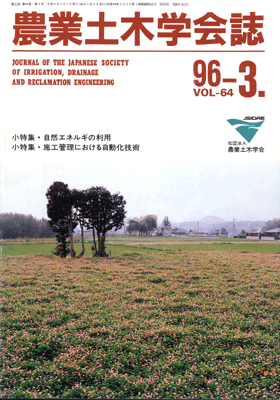Media Coverage
Pipe pressure control techniques by advanced pressure-reducing valve
|
Journal of the Japanese Society of Irrigation, Drainage and Reclamation
Engineering
Vol. 64, published on Mar. 1, 1996 |
|

|

|
|
Reprinted from Journal of the Japanese Society of Irrigation, Drainage
and Reclamation Engineering Vol.64 |
|
Pipe pressure control techniques by advanced pressure-reducing valve
 |
Hitone Inagaki
|

|
United Graduate School of Agricultural Sciences, Kagoshima University
|
 |
Masato Kunitake
|
|
Faculty of Agriculture, Miyazaki University
|
Abstract (English translation of the original text)
On the issue of necessary improvement of conventional automatic pressure-reducing
valves, an inline pressure reduction system employing a combination of
conventional automatic pressure-reducing and safety valves and/or airbags
has been offered aimed at eliminating the continuance of hydrostatic pressure
after water flow is stopped, and eliminating water hammer pressure on the
pressure-reducing valve. Currently, with the addition of improvements to
the operation mechanism of the automatic pressure-reducing valve which
allow serial arrangement of the valves, an actual system has been produced
and hydraulic testing has been performed.
The trial results produced the following confirmations: (1) A single pressure-reducing
valve allowed cut off of hydrostatic pressure of the upstream side, and
(2) several valves arranged in a series is also possible.
With the introduction of these new-type automatic pressure-reducing valves
on an inline pressure reduction valve-type system, it is expected that
there will be greater adoption of polyvinyl chloride piping due to the
ability for the progressive reduction of inline pressure.
|
Keywords:
|
Automatic pressure-reducing valve, Inline pressure reduction-type system,
hydraulic testing, serial arrangement, systematic internal pressure, polyvinyl
chloride piping.
|
For details of this advanced pressure-reducing valve, please refer to
Constant Pressure Valve (pressure reducing valve) UFSP type. |